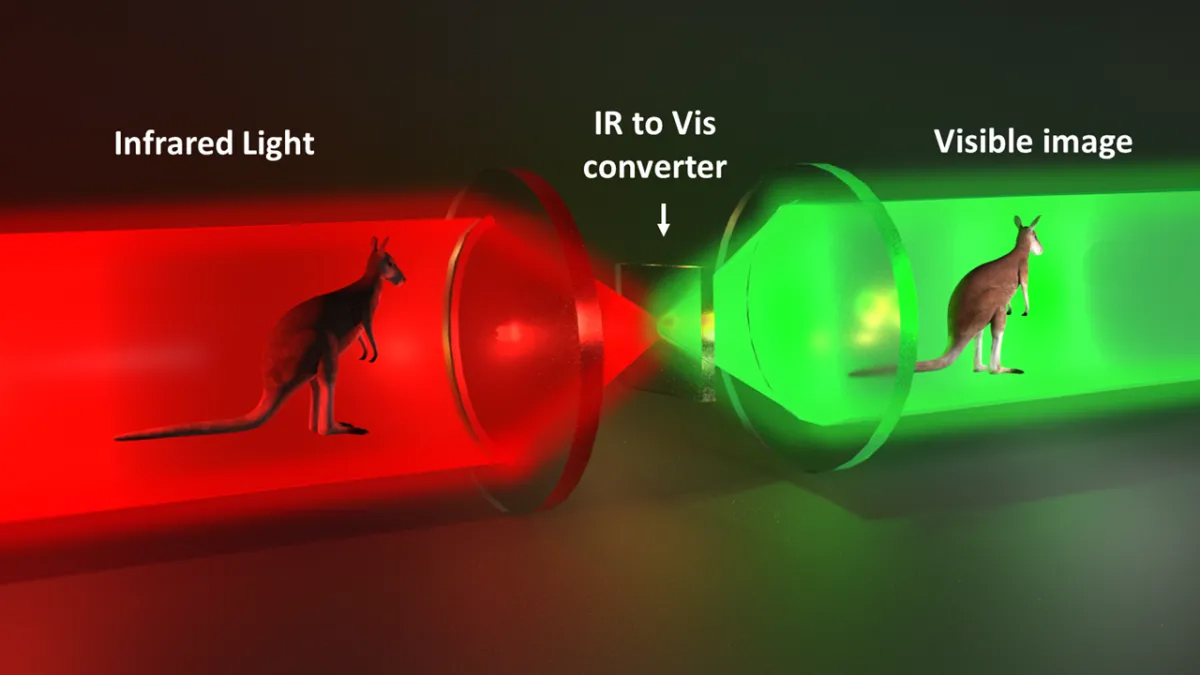'Night vision lenses' could give you power to see in the dark using simple eyeglasses
Super-slim night-vision tech could be within reach thanks to a new material breakthrough that can capture infrared and visible light at the same time.

One day we could have everyday eyewear with night vision, thanks to an ultra-thin material that can capture infrared and visible light at the same time.
In a new study published May 23 in Advanced Materials, researchers in Australia have found that by using "metasurface-based up-conversion technology", you can create a night vision effect without the need for bulky light-processing and cryogenic cooling components.
"These results promise significant opportunities for the surveillance, autonomous navigation, and biological imaging industries, amongst others," chief investigator Dragomir Neshev from the Australian Research Council’s Centre of Excellence for Transformative Meta-Optical Systems (TMOS) said in a statement. "Decreasing the size, weight and power requirements of night vision technology is an example of how meta-optics, and the work TMOS is doing, is crucial to Industry 4.0 and the future extreme miniaturisation of technology."
Related: Meta just stuck its AI somewhere you didn't expect it — a pair of Ray-Ban smart glasses
Traditional night-vision goggles work by visible light or infrared photons passing through a lens into an electronic image-intensifier tube consisting of a photocathode and a microchannel plate. The photocathode turns the photons into electrons, and these electrons then hit the microchannel plate, which has millions of holes that amplify their number. The electrons then interact with a phosphor-coated screen and exhibit a green glow, illuminating the scene that the wearer is viewing.
The researchers explained that this current setup poses challenges due to its large size for a head-mounted device, thermal noise and the inability to augment infrared and visible imaging.
However, by using an "ultra-compact, high-quality-factor lithium niobate resonant metasurface" — a very thin photonic device that can modulate the behavior of electromagnetic waves — the researchers boosted the energy of the infrared photons, increasing their frequency so as to bring their wavelengths within the visual spectrum.
Get the world’s most fascinating discoveries delivered straight to your inbox.
Let there be visible light
As the infrared photons only pass through a single resonant metasurface and are then mixed with a pump beam — a source of light used to amplify energy levels — night vision can be provided without the need to convert photons to electrons. This then bypasses the need for multiple heavy optical and cooling components to reduce thermal noise; the up-conversion from IR to visible light via the metasurface takes place at room temperature.
Furthermore, this up-conversion can capture both visible and nonvisible light in one image, which standard night-vision systems cannot as they must display images from each spectrum side-by-side. This leads to non-identical images. As such, the researchers found their approach offers direct imaging and edge detection via infrared simultaneously in a single view, enhancing the overall quality of a night-vision image.
This breakthrough has opened the path to smaller, slimmer and more efficient night-vision systems for a variety of applications, the scientists said. We could even see the advent of night-vision glasses or filters that could be worn over eyeglasses to help people see at night. Uses could range from helping keep track of a dog during an evening walk to making driving at night safer.
Roland Moore-Colyer is a freelance writer for Live Science and managing editor at consumer tech publication TechRadar, running the Mobile Computing vertical. At TechRadar, one of the U.K. and U.S.’ largest consumer technology websites, he focuses on smartphones and tablets. But beyond that, he taps into more than a decade of writing experience to bring people stories that cover electric vehicles (EVs), the evolution and practical use of artificial intelligence (AI), mixed reality products and use cases, and the evolution of computing both on a macro level and from a consumer angle.


